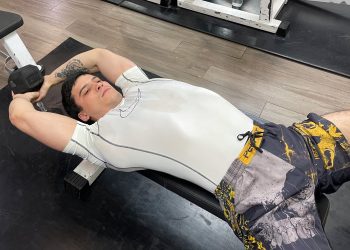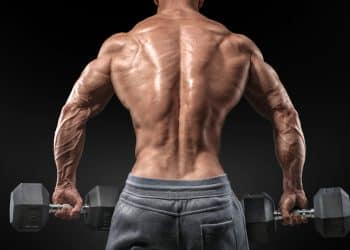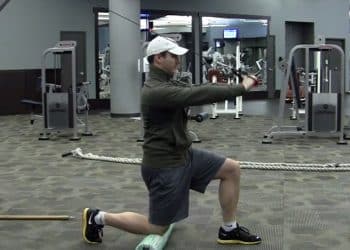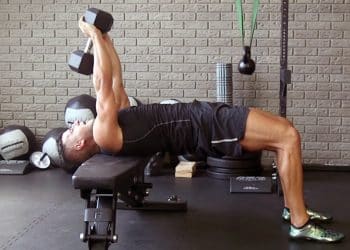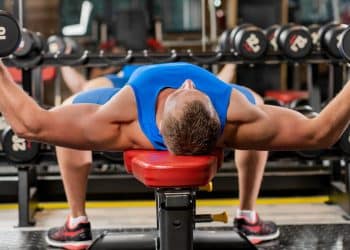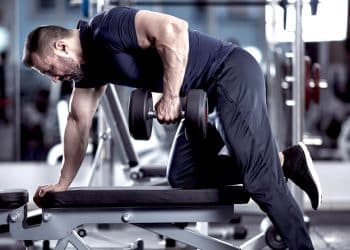If you want to build picture-perfect pecs, you need to pay equal attention to your upper, mid, and lower chest. Failure to attend to any of these pectoral regions could mean your chest development is less than impressive.
The upper and mid-pecs are relatively easy to train. Flat and incline bench presses will get the job done. Use dumbbells or barbells; it’s up to you!
However, the lower chest can be a little harder to train. Decline barbell bench presses can work, but they probably aren’t the best exercise for your needs and goals.
Don’t worry, though; there are several great exercises you can do that are guaranteed to bring your lower pecs up to scratch. All you need is a pair of dumbbells and an adjustable training bench.
We reveal the best dumbbell exercises for building a stronger, more muscular lower chest.
Chest Anatomy
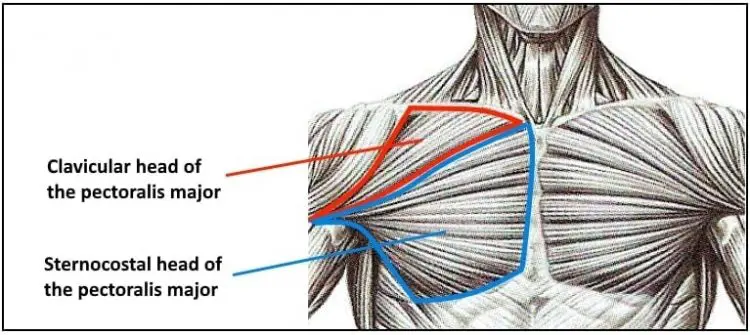
Level Up Your Fitness: Join our 💪 strong community in Fitness Volt Newsletter. Get daily inspiration, expert-backed workouts, nutrition tips, the latest in strength sports, and the support you need to reach your goals. Subscribe for free!
While you don’t need a ton of anatomy knowledge to develop a lower chest you can be proud of, it will be helpful to understand how the chest muscles work so you can identify the best exercises for the task at hand.
That said, if you aren’t interested in muscle anatomy and physiology, you are free to skip this section and go straight to the exercises!
Your chest is made up of two main muscles:
Pectoralis major – known as your pecs for short, this is the largest chest muscle. Its main functions are horizontal flexion, adduction, and medial rotation of your shoulder joint.
While the pecs are a single muscle, they are made up of several groups of fibers, often referred to as heads.
- Clavicular head – this is your upper chest. It’s more active during incline movements, such as incline bench press and incline flyes.
- Sternal head – the most prominent pec head, this region forms the bulk of your chest. It’s most active during flat pec exercises, such as flat bench presses and pec deck.
- Abdominal head – this is your lower chest and the focus of this article. Exercises like dips and high-to-low cable crossovers emphasize this region of your pecs. However, dumbbell exercises are often the best way to train the lower pecs.
Pectoralis minor – pec minor is a thin, flat muscle that lies underneath the pec major. It assists your pec major during most chest exercises and prevents your shoulders from lifting as you move them. Pec minor does not contribute much to chest size, but it’s still an important muscle. Pec minor often works with the lower pecs.
While it is impossible to isolate the sections of your chest, it is possible to perform exercises that emphasize each region. If you want to increase lower chest size and strength, exercises that work your pecs from a declined position are usually best.
Lower Chest Exercises Using a Dumbbell
Building the lower pecs can be hard, but it’s not impossible. After all, bodybuilders throughout history have built shelf-like lower pecs, and if they can do it, so can you! Decline barbell bench presses and dips are probably the most common ways to train the lower pecs, but if those methods aren’t working for you, it’s time to break out the dumbbells.
Training your lower pecs with dumbbells offers several notable benefits:
Increased range of motion – using dumbbells rather than a barbell means you can lower the weights below your chest, getting a great stretch in the pecs and making every rep more effective. This massive advantage will help you build bigger lower pecs faster.
Shoulder-friendly – bench presses and dips are notoriously hard on your shoulders and often cause shoulder pain. That’s because they lock your hands into a fixed position, which puts unnatural stress on your joints.
When you train with dumbbells, the weights are free to rotate, making your lower chest workout much more shoulder friendly.
No more strength imbalances – most people have one arm stronger than the other. Small imbalances are nothing to worry about, but more significant differences can lead to one side of your body developing faster than the other and may even cause aches and pains. Dumbbells make identifying, preventing, and fixing any left-to-right imbalances easier.
The Best Lower Chest Dumbbell Exercises
Take the guesswork out of your lower chest workouts and make every rep count with these tried-and-tested lower chest dumbbell exercises!
1. Decline Dumbbell Fly
The decline dumbbell fly is a classic lower chest exercise. Whether you do it at the start or the end of your lower chest workout, this move will help sculpt your lower and inner pecs.
Steps:
- Set your bench to a 10 to 30-degree decline. Lie on the bench with your head lowermost and a dumbbell in each hand.
- Press the weights up and hold them over your chest, palms facing inward. Bend your elbows slightly and then keep them rigid throughout.
- Pull your shoulders down and back, and brace your abs.
- Open your arms and lower the weights out and down to the sides to form a T-shape. Get a good stretch in your chest but take care not to hyperextend your shoulders.
- Squeeze your arms back together and repeat.
Muscles targeted:
- Primary: Lower pecs.
- Secondary: Anterior deltoids.
Benefits:
- Emphasize the lower pecs without training the triceps.
- Get a good workout using light to moderate weights.
- Less shoulder strain than flat and incline dumbbells flyes.
Tips:
- Perform 12-20 reps per set using light to moderate weights for best results.
- Do not go below 30 degrees decline, as doing so makes the exercise less effective.
- Use a spotter if training to failure to avoid accidents and injuries.
2. Decline Dumbbell Twist Fly
The decline twist fly builds on exercise #1 and adds extra shoulder rotation to maximize lower pec engagement. However, there is a tradeoff as this additional movement may mean you cannot use such heavy dumbbells.
Steps:
- Set your bench to a 10 to 30-degree decline. Lie on the bench with your head lowermost and a dumbbell in each hand.
- Press the weights up and hold them over your chest, palms facing inward. Bend your elbows slightly and then keep them rigid throughout.
- Pull your shoulders down and back, and brace your abs.
- Open your arms and lower the weights down and out to the sides.
- Squeeze your arms back together and, as the dumbbells come together, twist the dumbbells and your little fingers inward so the bottoms of the weights lightly touch.
- Open your arms and repeat.
Muscles targeted:
- Primary: Lower pecs.
- Secondary: Anterior deltoids.
Benefits:
- Increase peak muscle contraction for a stronger mind-muscle connection.
- Get a good lower pec workout even if you only have access to light dumbbells.
- Hit your lower pecs hard without training your triceps.
Tips:
- Perform 12-20 reps per set using light to moderate weights for best results.
- Keep your elbows slightly bent but rigid to put more stress on your lower chest.
- Try supersetting this exercise with push-ups for a quick but effective lower chest workout.
3. Decline Dumbbell Circle Fly (Decline Dumbbell Around the Worlds)
This exercise is typically done on a flat or incline bench. Still, there is no reason you can’t do it using a decline bench to emphasize your lower chest. Use light weights, as this move is much harder than it looks!
Steps:
- Lie on your decline bench with your head lowermost. Press your dumbbells up and hold them over your chest.
- Bend your elbows slightly and then keep them rigid throughout. Lower the weights behind your head, so your upper arms are next to your ears. Your palms should be facing upwards. This is your starting position.
- Keeping the weights level with your body, circle your arms forward until the dumbbells meet above your hips.
- Return to the starting position and repeat.
Muscles targeted:
- Primary: Lower pecs.
- Secondary: Anterior deltoids.
Benefits:
- A great exercise for improving shoulder mobility.
- Provides an excellent lower chest workout even with light dumbbells.
- A good way to warm up your pecs and shoulders before heavier lifting.
Tips:
- Do 8-12 reps with light to moderate weights.
- Use a slow, smooth tempo to keep the tension on your muscles.
- Start with a slight decline, e.g., 10 degrees, and gradually increase the angle as you get used to the exercise.
4. Decline Dumbbell One Arm Fly
Is one side of your chest stronger or better developed than the other? Don’t worry; you are not alone! This exercise will fix any left-to-right strength imbalances and also strengthen that all-important mind-muscle connection.
Steps:
- Lie on your decline bench with your head lowermost. Using a single dumbbell, press the weight up and hold it over your chest. Turn your palm inward. Brace your abs and pull your shoulders down and back.
- Lower the dumbbell down and out to the side as far as possible without hyperextending your shoulder.
- Pull the dumbbell back up and in, and then repeat.
- Rest a moment, and then do the same number of reps on the opposite side.
Muscles targeted:
- Primary: Lower pecs.
- Secondary: Anterior deltoids.
Benefits:
- Identify and fix left-to-right strength imbalances.
- A useful exercise if you are injured and cannot train both arms.
- Get a great workout even if you only have a single dumbbell to train with.
Tips:
- Use light to moderate weights and do 12-20 reps per set.
- Brace your abs to stabilize your lower body and eliminate unwanted movement.
- Adopt a wider stance for increased stability.
5. Decline Dumbbell Press
Lower chest isolation exercises like decline dumbbell flyes are great, but they do not allow you to lift heavy weights. In contrast, compound decline presses are perfect for heavy dumbbells, and that makes them better for building strength.
Steps:
- Holding a dumbbell in each hand, lie on your decline bench with your head lowermost. Hold the dumbbells over your chest with your arms straight and palms facing down your body. Pull your shoulders down and back, and brace your core.
- Bend your elbows and lower the dumbbells down and out to your shoulders. Keep your wrists straight.
- Push the dumbbells back up and in to complete your rep.
Muscles targeted:
- Primary: Lower pecs.
- Secondary: Anterior deltoids, triceps.
Benefits:
- A shoulder-friendly alternative to flat bench presses.
- An excellent exercise for lifting heavy weights and building strength AND muscle size.
- More comfortable and effective than barbell decline presses.
Tips:
- Do 6-10 reps with heavy to moderate weights.
- Wear wrist wraps when training with heavy weights to stabilize your joints.
- Use a full range of motion to maximize lower pec engagement.
- Try doing this exercise with an alternating arm action for variation.
6. Decline Dumbbell Close Grip Press
The decline dumbbell close grip bench press not only hammers your lower chest but your inner chest, too. This exercise delivers a very satisfying chest pump and creates huge amounts of tension in the target muscles. Try it; you’re going to love it!
Steps:
- Lie on your decline bench with your head lowermost. Press your dumbbells up and hold them over your chest. Press the dumbbells together. Pull your shoulders down and back, and brace your abs.
- Maintaining inward pressure on the dumbbells, bend your arms and lower the weights to your chest.
- Push the dumbbells back up and repeat.
Muscles targeted:
- Primary: Lower pecs.
- Secondary: Anterior deltoids, triceps.
Benefits:
- Train your inner and lower chest simultaneously.
- A good exercise for using heavier weights and building strength.
- Very shoulder-friendly – good for anyone with joint pain.
Tips:
- Push the weights together as hard as possible to maximize pec engagement.
- Use hexagonal dumbbells if available.
- Do 6-10 reps per set using heavy to moderate weights.
7. Decline Dumbbell Hammer Press
Some people find the standard overhand or pronated grip dumbbell press uncomfortable. A neutral or hammer grip is an excellent alternative if you don’t like or cannot do regular dumbbell decline presses.
Steps:
- Lie on your decline bench with a dumbbell in each hand. Hold the weights over your chest with your palms facing inward, i.e., a neutral or hammer grip. Brace your abs and pull your shoulders down and back.
- Bend your elbows and lower the weights down to your shoulders. Keep your upper arms close to your sides.
- Drive the weights back up to full arm extension and repeat.
Muscles targeted:
- Primary: Lower pecs.
- Secondary: Anterior deltoids, triceps.
Benefits:
- A very comfortable, shoulder-friendly exercise.
- Perfect for heavy dumbbell training and building strength.
- Increased triceps engagement for a more complete upper body workout.
Tips:
- Do 6-10 reps per set with heavy to moderate-weight dumbbells.
- Keep your upper arms tucked into your sides to protect your shoulders and maximize muscle engagement.
- Use a spotter if training with heavy weights or to failure.
- Try doing this exercise with an alternating arm action for variation.
8. Dumbbell Hip Bridge Floor Press
No decline bench? No problem! You can still get a great lower chest workout with nothing but a pair of dumbbells and a few square feet of floor space. This move is ideal for home exercisers.
Level Up Your Fitness: Join our 💪 strong community in Fitness Volt Newsletter. Get daily inspiration, expert-backed workouts, nutrition tips, the latest in strength sports, and the support you need to reach your goals. Subscribe for free!
Steps:
- Lie on the floor with your legs bent and feet flat. Hold a dumbbell in each hand over your chest. Press your upper back into the floor and brace your abs.
- Push your feet into the floor and lift your hips up to replicate lying on a decline bench.
- Bend your arms and lower the weights down toward your shoulders. Touch your upper arms/elbows lightly to the floor.
- Drive the weights back up and repeat.
Muscles targeted:
- Primary: Lower pecs.
- Secondary: Anterior deltoids, triceps, gluteus maximus, hamstrings.
Benefits:
- No bench is required to do this exercise.
- Very shoulder-friendly.
- Suitable for heavy weight, low rep strength training.
Tips:
- Lie on a mat for comfort.
- Do 6-10 reps with heavy to moderate weights.
- Perform with just one dumbbell or using an alternating arm action for variety.
9. Dumbbell Pullover
A lot of exercisers view dumbbell pullovers as a lat exercise – and they’re right! However, the pullover is also an excellent lower chest exercise. Dumbbell pullovers are an isolation exercise that also manages to work all of your major torso muscles.
Steps:
- Lie on a flat or slightly declined bench. Hold a single dumbbell over your chest. Bend your arms slightly but then keep them rigid. Pull your shoulders down and back, and brace your abs.
- Without bending your arms further, lower the dumbbell back and behind your head until your biceps are next to your ears. Try not to hyperextend your lower back.
- Pull the dumbbell back up, so your arms are perpendicular to your body.
Muscles targeted:
- Primary: Lower pecs and lats.
- Secondary: Triceps (long head).
Benefits:
- A good exercise for mobilizing the shoulders and stretching the lats.
- Build your lats and pecs simultaneously.
- Can be performed on a flat bench if necessary; no decline bench is required.
Tips:
- Do 12-20 reps with a moderate to light weight.
- Increase your range of motion and make this exercise more shoulder-friendly by using two dumbbells instead of one.
- Try lying across rather than along your bench to increase your range of motion for a more demanding workout.
FAQs:
Do you have questions about lower chest training with dumbbells? Well, we’ve got the answers!
Which is better for lower chest training: bodyweight exercises, machines, dumbbells, or barbell?
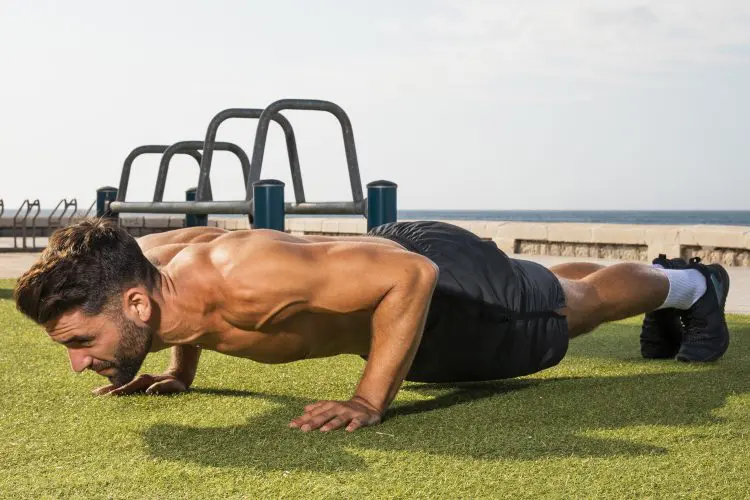
In truth, the best option is the one you a) have access to, b) enjoy, and c) can do without discomfort or risk of injury. For some people, that may be bodyweight or dumbbell exercises. But, for others, barbells or machines may be better.
So, either use what you’ve got and enjoy or try all the available options to see which works best for you.
Ultimately, your muscles cannot easily tell the difference between lifting dumbbells or using something like cables, so there is no need to favor or discriminate between training methods as they all work.
How often should I do lower chest dumbbell exercises?
You can train your lower chest anywhere from one to three times per week. If you train it once, you’ll need to do a lot of sets in your workout, e.g., ten or so. This means doing several different lower chest exercises for 3-4 sets each:
| # | Exercise | Sets | Reps |
| 1 | Decline dumbbell bench press | 4 sets | 6-10 reps |
| 2 | Decline dumbbell flyes | 3 sets | 15-20 reps |
| 3 | Decline dumbbell circle flyes | 3 sets | 15-20 reps |
Or, if you want to train your lower pecs more frequently, you can do fewer exercises and sets per workout to accumulate a similar amount of volume:
Monday
| # | Exercise | Sets | Reps |
| 1 | Decline close grip dumbbell bench press | 3 sets | 6-10 reps |
| 2 | Decline dumbbell twist flys | 3 sets | 10-12 reps |
Thursday
| # | Exercise | Sets | Reps |
| 1 | Dumbbell hip bridge floor press | 3 sets | 6-10 reps |
| 2 | Decline dumbbell one-arm fly | 3 sets | 12-15 reps per arm |
Try both options for a few weeks to see which works best for you.
How can I prioritize my lower chest?
Prioritizing your lower chest is probably the best way to increase its size quickly. There are a couple of ways to do this:
- Make lower chest training your first workout of the week.
- Train your lower chest before you work your middle and upper chest.
- Train your lower chest 2-3 times a week and not just once.
- Use the 3:2:1 method…
With the 3:2:1 method, you do three sets for your lower chest, two for your upper chest, and one for your mid-chest, so your lower pecs get more training stress and grow faster.
For example, using the 3:2:1 method, your next chest workout might look something like this:
| # | Exercise | Sets | Reps |
| 1 | Decline dumbbell bench press | 3 sets | 8-12 reps |
| 2 | Incline dumbbell flyes | 2 sets | 12-15 reps |
| 3 | Horizontal chest press machine | 1 sets | 10-12 reps |
This approach means you can put more energy into the lower pecs while maintaining mid and upper-chest size and strength. Use this method twice per week for best results, e.g., Tuesday and Friday, using different exercises to avoid boredom.
Should I mix up dumbbell exercises with other exercises?
There is no reason not to! While dumbbell lower chest exercises are effective, there is no need to limit yourself to just one training modality. If you have access to other training methods and enjoy using them, you can also include them in your workouts. Other effective lower chest exercises include:
- Decline barbell bench press
- Chest dips
- High to low cable crossovers
- Push-ups
- Decline chest press machine
Will the lower chest exercises hit my upper chest too?
Yes indeed! Your pecs are a large, fan-shaped muscle with three heads. While you can emphasize each head by altering the angle of your arms, they all work together. However, it is impossible to isolate your lower pecs and leave your upper chest out of whatever exercise you are performing.
So, all chest exercises work all the parts of your chest. Still, you can place more tension on each of the three heads by performing specific exercises. As a general rule:
- Incline exercises work mostly your upper chest.
- Flat exercises work mostly your middle chest.
- Decline exercises work mostly your lower chest.
Why isn’t my lower chest growing?
There is nothing more frustrating than training without getting results. There are several reasons why your lower chest might not be responding the way you want:
Not consuming enough protein – your body needs protein for muscle growth. Make sure you consume 0.7 to 1.0 grams of protein per pound of body weight.
Not training hard enough – make sure you take your sets to within a couple of reps of failure. Easy workouts do not build muscle!
You are skipping too many workouts – even the best exercises won’t work if you don’t do them often enough. Train your lower chest 1-3 times per week without fail. Stick to your training program unless you are ill or injured.
You’re overtraining – when it comes to exercise, you can have too much of a good thing. You need to balance your workouts with adequate recovery. Make sure you have a few rest days per week, eat healthily, and get plenty of sleep. You may also need to dial back the cardio, so you’ve got more energy to dedicate to muscle growth and recovery.
You’ve been following the same workout for too long – doing the same program over and over will eventually lead to a training plateau. Avoid this problem by changing your training plan every 6-8 weeks or whenever you notice your gains starting to slow down.
You’re losing fat and gaining muscle – your chest might not look like it’s growing, but the shape will change dramatically if you are losing fat as you gain muscle mass. Worry less about your chest measurement and focus more on how it looks. If your appearance is changing for the better, you are on the right track.
You’ve not been training long enough – building muscle takes time. If you’ve only been training for a few months, you probably won’t see much lower pec growth. So, be patient and consistent, and the gains will come. In 12 months from now, you’ll be unrecognizable!
More Chest Workouts and Exercises:
- Lower Chest Workouts and Exercises for a Sculpted Chest
- Upper Chest Workouts and Exercises To Build Strength and Size
- Old School Exercises to Build Your Chest
- Compound, Isolation, and Bodyweight Chest Exercises
- Dumbbell Chest Exercises You Can Do Without a Bench
- Cable Chest Exercises to Develop Serious Pec Power
- TRX Chest Exercises (Plus Workout) For Bigger Chest Gains
- Chest Exercises For Building Bigger Pecs
- Chest Exercises You Can Do At Home
Closing Thoughts
When it comes to chest training, most people head for the barbell bench press. While that might be a good exercise for general pec building, it doesn’t do much for your lower chest. Neglecting the lower chest can affect your appearance and leaves a lot of muscle mass undeveloped.
Use the exercises and advice in this article to build a lower chest you can be proud of. All you need is some dumbbells, an adjustable bench, and the willingness to work hard.
Prioritize your lower pecs, and you will be amazed at what you can achieve!


